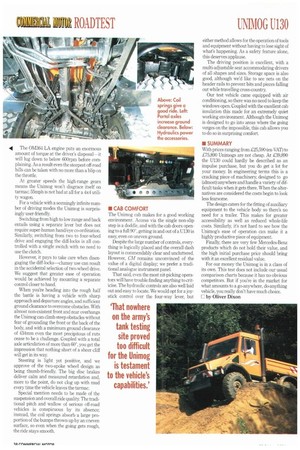r j TIjfJi1 LTS ROADTEST
Page 40

If you've noticed an error in this article please click here to report it so we can fix it.
The 0M364 LA engine puts an enormous amount of torque at the driver's disposal—it will lug down to below 600rpm before complaining. As a result even the steepest off-road hills can be taken with no more than a blip on the throttle.
At greater speeds the high-range gears means the Unimog won't disgrace itself on tarmac; 55mph is not bad at all for a 4x4 utility wagon.
For a vehicle with a seemingly infinite number of driving modes the Unimog is surprisingly user-friendly Switching from high to low range and back entails using a separate lever but does not require super-human hand/eye co-ordination. Similarly, switching from two to four-wheel drive and engaging the diff-locks is all controlled with a single switch with no need to use the clutch.
However, it pays to take care when disengaging the diff-locks—clumsy use can result in the accidental selection of two-wheel drive. We suggest that greater ease of operation would be achieved by mounting a separate control closer to hand.
When you're heading into the rough half the battle is having a vehicle with sharp approach and departure angles, and sufficient ground clearance to overcome obstacles. With almost non-existent front and rear overhangs the Unimog can climb steep obstacles without fear of grounding the front or the back of the body, and with a minimum ground clearance of 434min even the most precipitous of ruts cease to be a challenge. Coupled with a total axle articulation of more than 60°, you get the impression that nothing short of a sheer cliff will get in its way Steering is light yet positive, and we approve of the two-spoke wheel design as being thumb-friendly. The big disc brakes deliver calm and measured retardation and, more to the point, do not clog up with mud every time the vehicle leaves the tarmac.
Special mention needs to be made of the suspension and overall ride quality. The traditional pitch and wallow of serious off-road vehicles is conspicuous by its absence; instead, the coil springs absorb a large proportion of the bumps thrown up by an uneven surface, so even when the going gets rough, the ride stays smooth. The Unimog cab makes for a good working environment. Access via the single non-slip step is a doddle, and with the cab doors opening to a full 90°, getting in and out of a U130 is easy, even on uneven ground.
Despite the large number of controls, everything is logically placed and the overall dash layout is commendably clear and uncluttered. However, CM remains unconvinced of the value of a digital display; we prefer a traditional analogue instrument panel.
That said, even the most nit-picking operators will have trouble finding anything to criticise. The hydraulic controls are also well laid out and easy to locate. We would opt for a joystick control over the four-way lever, but either method allows for the operation of tools and equipment without having to lose sight of what's happening. As a safety feature alone, this deserves applause.
The driving position is excellent, with a multi-adjustable seat accommodating drivers of all shapes and sizes. Storage space is also good, although we'd like to see nets on the header rails to prevent bits and pieces falling out while travelling cross-country Our test vehicle came equipped with air conditioning, so there was no need to keep the windows open. Coupled with the excellent cab insulation this made for an extremely quiet working environment. Although the Unimog is designed to go into areas where the going verges on the impossible, this cab allows you to do so in surprising comfort.
With prices ranging from £25,590 (ex-VAT) to £75,890 Unimogs are not cheap. At £39,890 the U130 could hardly be described as an impulse purchase, but you do get a lot for your money. In engineering terms this is a cracking piece of machinery, designed to go (almost) anywhere and handle a variety of difficult tasks when it gets there. When the alternatives are considered the costs begin to look less fearsome.
The design caters for the fitting of auxiliary equipment to the vehicle body so there's no need for a trailer. This makes for greater accessibility as well as reduced whole-life costs. Similarly, it's not hard to see how the Unimog's ease of operation can make it a highly productive piece of equipment.
Finally, there are very few Mercedes-Benz products which do not hold their value, and the high initial purchase price should bring with it an excellent residual value.
For our money the Unimog is in a class of its own. This test does not include our usual comparison charts because it has no obvious competitors. But if you're in the market for what amounts to a go-anywhere, do-anything vehicle, you really don't have much choice.
E by Oliver Dixon
















































































































